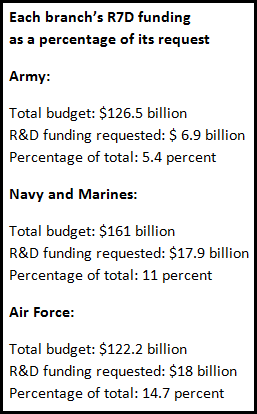Budget requests reveal military's R&D priorities
From cyber to lasers and dual manned/unmanned systems, the military services focus on the future.
Parsing through budget requests can be a great way to gain insight into the future of the military. It demonstrates where the service’s priorities are, especially in today’s climate of sequestration and budget constraints.When funding is tight, the military must choose what they feel is most important.
Research and development is a key aspect in determining where the military services want to go, what they feel is important to their specific branch, and what they see as the particular threats they face. Whether they'll get everything they've asked for is another story, of course, but here is a rundown of the R&D priorities of each branch from the 2016 Defense budget request:
Army
Maj. Gen. Thomas Horlander, director for Army budget, told a room full of reporters at a budget briefing that the Army’s research, development, testing and evaluation (RDT&E), coupled with procurement accounts, make up only 18 percent of the budget. Horlander noted that this funding amount is the lowest since the beginning of the century; in previous years, those programs made up between 20 percent and 22 percent of the entire budget. To match dollar amounts with these percentages, the Army requested a total budget of $126.5 billion, with $23 billion for RDT&E and procurement funding combined. Procurement takes up $16.1 billion of that total, with RDT&E accounting for $6.09 billion.
Deputy Director for Army budget Davis Welch at the same briefing noted that while the Army did not terminate any programs, allocating funds to preserve science and technology funding through 2025, several high-dollar programs have been forced to be put on the back burner. Some of these delayed programs include the future infantry fighting vehicle, the Armed Aerial Scout and full-on-the-move tactical networking.
Among top procurements the Army is targeting are Blackhawk and Apache attack helicopters, Chinook helicopters, WIN-T communication systems, and the MQ-1 Gray Eagle, a dual-purpose weaponized/ISR unmanned aircraft. Areas in RDT&E specifically identified by the Army include basic research, applied research advanced technology development, demonstration/validation, engineering manufacturing development, testing and management support and operational system development.
Mr. Welch noted that the Army is seeking $43 million for a “high-energy laser program to demonstrate laser technology focused on defeating rockets, artillery, mortars, unmanned aircraft and cruise missiles.” The Army has stated that, long term, they wish to provide 360-degree awareness for pilots to operate in all types of environments.
Lastly, the Army has increased its non-science and technology RDT&E funds to $89.4 million to go toward the cyber and big data programs to protect from insider and outsider threats.
Navy
In a briefing at the Pentagon, Deputy Assistant Secretary of the Navy for Budget Rear Adm. William K. Lescher outlined the R&D landscape for the Navy and Marines for the next year. From a total of $161 billion, the Navy and Marines plan to spend $17.9 billion on R&D – 11 percent of the total combined budget, with breakdowns coming to 13 percent of the Navy budget and 3 percent of the Marine budget.
The Navy in recent years has emphasized its desire for more unmanned systems. Adm. Jonathan Greenert, chief of Naval Operations, called for greater stamina for unmanned underwater vehicle propulsion systems at the Naval Future Force Science and Technology (S&T) Expo in Washington this week. Greenert also said the Navy wants next-generation strike aircraft to be interchangeable between manned and unmanned. Lescher cited one such system, the UCLASS, or unmanned carrier-launched airborne surveillance and strike program.
Marine Corps R&D will focus on amphibious combat vehicles, Lescher said. The Marines have already awarded contracts to two vendors for procurement of additional vehicles.
In the cyber domain, networks such as NGEN and the Consolidated Afloat Networks and Enterprise Services will see more investment, as will combat and controls systems for tactical platforms.
Air Force
The Air Force is putting a heavy emphasis on innovation and technology, requesting $18 billion for R&D, a $2 billion increase from last year, and $25.3 billion for procurement, up from $19 billion previously, as part of a budget of $122.2 billion. Addressing reporters this week, Maj. Gen. James Martin, Air Force director of budget, said that “Research, development, testing and evaluation is where big ideas make the leap from just an idea to technology we use every day. This appropriation directly supports the Air Force's vision of world's greatest Air Force powered by airmen, fueled by innovation. Innovation is at the core of our identity.”
Space also is an Air Force priority, and Martin said budget request leaves room to support two competitive rocket launch providers.
NEXT STORY: DOD leaders take their place in the Fed 100





